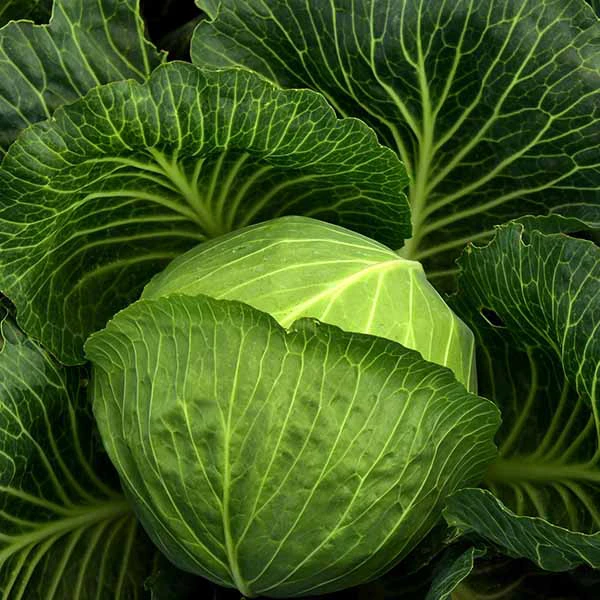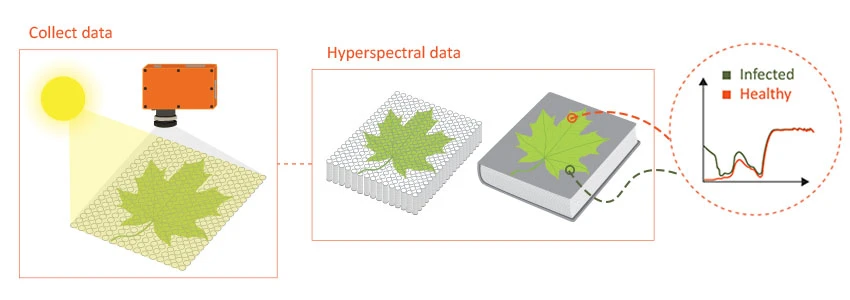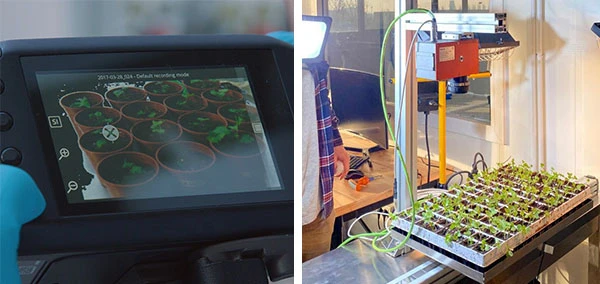How Is Hyperspectral Imaging Used in Agriculture?

For centuries, agricultural researchers and producers have relied on traditional methods, like visual inspection, etc., to monitor and manage their crops. While these methods may be effective to some degree, they often lack the precision and real-time information that modern technologies like hyperspectral imaging (HSI) provide. In recent years, hyperspectral imaging has become an invaluable tool within the agriculture industry and is transforming how we monitor and manage crops.
How Hyperspectral Imaging Works

Illustrative example of hyperspectral imaging in agriculture
Hyperspectral imaging captures images of an object or scene at various wavelength sections of the electromagnetic spectrum. Unlike traditional imaging, which captures images using only three color channels (red, green, and blue), hyperspectral imaging uses many narrow and contiguous spectral channels, typically ranging from ultraviolet to infrared.
When an object is illuminated with light, it reflects or absorbs different wavelengths of light based on its material properties. For instance, a red apple reflects more red light than blue light. Hyperspectral imaging takes advantage of this phenomenon to differentiate between different materials and colors. By analyzing the amount of light reflected or absorbed by an object at each spectral channel, hyperspectral imaging can create a spectral signature or fingerprint unique to that object.
The spectral signature of an object contains information about its composition, chemical properties, color, etc. Different materials and colors have unique spectral signatures that can be detected and analyzed using hyperspectral imaging. For example, a red apple and a green apple will have different spectral signatures due to their different coloration. Similarly, a healthy plant and one infected with diseases will have different spectral signatures due to their physiological characteristics.
Hyperspectral Applications in Agriculture
With its ability to provide detailed information about plants or vegetation in a non-destructive manner, hyperspectral imaging can be used for a wide range of agriculture applications. Below are some of the common uses of hyperspectral imaging in agriculture.
- Crop health assessment and monitoring. One of the primary uses of hyperspectral imaging in agriculture is to monitor the health of crops by detecting stress caused by factors such as disease, nutrient deficiencies, pests, etc. By detecting stress early, agricultural producers can take action to mitigate it before the issues become widespread and significantly impact crop yields.
- Quality assessment. Another common hyperspectral imaging application in agriculture is the quality assessment of harvested crops. By analyzing the spectral signatures of crops, agricultural producers can identify issues such as bruising, decay, insect damage, etc.
- Soil assessment and monitoring. Hyperspectral imaging can also be used to gain valuable insights into the composition and health of soils. For example, using the data obtained by hyperspectral sensors or cameras, agricultural producers can predict and assess soil properties like soil moisture, soil organic carbon, and nitrogen content – all of which are significant for plant growth and crop yields.
Specim Hyperspectral Cameras for Agriculture

Portable hyperspectral camera Specim IQ (left) and hyperspectral camera Specim FX10 (right).
Image courtesy of SPECIM, SPECTRAL IMAGING LTD.
Specim, a part of the Konica Minolta Sensing, offers a wide selection of pushbroom (line scan) hyperspectral cameras and solutions that are applicable to various agriculture applications. Their selection includes the portable hyperspectral camera suitable for lab or on-site use to industrial-grade hyperspectral cameras, which can easily be integrated into any existing machine vision system, up to airborne hyperspectral systems.
Konica Minolta sensing has an extensive selection of instrumental solutions for agricultural researchers and producers looking to ensure quality in their research, production, or control. In addition to hyperspectral cameras, our array of instrumental offerings includes color measurement instruments that can be used to evaluate and manage the quality and maturity of crops and light meters that can measure the light source output in indoor farming. Visit our comprehensive collection of instrumental solutions tailored specifically for the agriculture industry right here.
Wish to learn more about Specim hyperspectral cameras and solutions? Or need help finding the right instrumental solutions for your agriculture application needs? Our expert team is here to assist you. Request your free consultation with us now.
